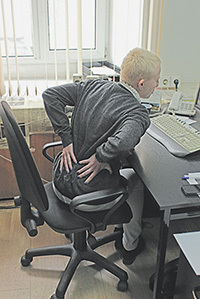
Pain in the back, pain in the lower back – there is no man who would not once in my life experienced. According to the World health organization, is the most common complaint and the most common reason of temporary disability.
What to do?
The phenomena of degenerative-dystrophic changes of the spine is often referred to as the outdated term "osteochondrosis". These phenomena are detected by the absolute majority of people over the age of 18 years. By itself, the word "osteochondrosis" includes anything: from the age norm in the most difficult pathology. This term reluctantly, is used by most neurosurgeons, and is generally used in the international literature.
Pain in the back can be a self-problem ("took", "gelidus back", etc.), but it may signal a disease of the spine, about a variety of serious conditions, from pyelonephritis and influenza virus to the tumor of the spinal cord or metastases to the vertebrae. Therefore, pain in the back – it is a symptom that requires diagnosis.
Clearly a diagnosis of back pain is needed in the following cases: pain arose after the injury, falls, traffic ACCIDENTS; severe pain persists for several days, preventing a walk and/or sleep; pain in the lower back gives in feet/legs (buttocks, thigh, lower leg/spawn and foot); during torpor, crawling sensation of chills in my leg/foot; reduction in force in any part of the feet/legs; how to lose weight legs/feet; difficult or frequent urination, defecation; when severe pain in the elderly; when strong pain in the back at macie, weakened or in person with a temperature; when the back pain in a patient who has severe systemic disease, such as osteoporosis, cancer, tuberculosis.
Understandable, the desire to find out why it hurts the shoulders. Start preferably with magnetic resonance imaging (MRI) of the lumbar-sacral spine. All other actions, including a visit to the doctor, then. On MRI need to spend a few thousand rubles, but do without a doctor's recommendation.
The conclusion, written by a specialist in radiation diagnosis, often scares the patient. There may be written: hernia / protrusion / stenosis / osteochondrosis / hernia Smorlya / spondiloartrozom. It can mean anything, including nothing. Just describes the MR-phenomena. Must be interpreted by the Doctor with regard to history, images of disease, further studies and many more. The conclusion is written not for the patient, but for another doctor.
Radiography and computed tomography in the vast majority of cases – more research, the directors of the doctor.
By MRI roast, need to go to a neurologist or neurosurgeon. The second thing on my subjective opinion that it is preferable: in the average operating neurosurgeons significantly better artist images, because every day to see real pictures of the surgery and compare them with the MRI, and the clinical picture. In some cases, which says a neurologist or a neurosurgeon, you need an orthopedist.
If according to the results of the inspection and evaluation of magnetic resonance imaging surgery is not required (most often this is done), the treatment is carried out under the control of a neurologist. In typical cases, this includes non-steroidal anti-antiinflammatory drugs, muscle relaxants and other medications. Sometimes it is necessary to look for other methods. Determine the method and length of treatment can only a doctor.
I pain in lower back, and especially without the MRI, a very unreasonable step. The use of alternative medicine, again – especially without the MRI, the uniform is stupid.
Sometimes the doctor said that it is necessary to remove the herniated disc. Thanks to the use of endoscopic and microsurgical technologies in the skillful hands of this operation is relatively safe. I usually tell my patients that the risk of paralysis or other serious complications during removal of the disc herniation approximately equal to the risk of death in a traffic ACCIDENT on the way to the consultation.
Many fear that since the surgery on the spine can paralyze. It is practically impossible. Occur dangerous operations associated with such a risk, such as the removal of intramedullary tumors, the operations, when fractures of the thoracic spine, etc. If such a danger exists, notify. When removal of the disc herniation, the removal of stenosis of the spinal canal, the risk of these complications theoretical. Condition of safety is the qualifications of the neurosurgeon and the availability of the clinic modern equipment.
There are diseases in which is needed to stabilize the spine – installation of special constructions, which hold the vertebrae with each other. Ways to stabilize and systems for the stabilization of very many. Stabilization of the spine is performed only on strict. Should be in it can be determined only by a neurosurgeon. The most stabilizing operations necessary when stenosis stenosis, spondylolisthesis, instability of vertebral segments, fractures of the spine.
After most operations on the spine, not only that you will not have long to lie, but often the patient begins to walk on the second morning after surgery, or even in the evening on the day of surgery.
What you need to do, to hurt the shoulders? In private clinics it is possible to find commercial programs for struggle with back pain on the value of the car. It is scientifically proven that they are in fact quite a lot of basic things.
Above all, it must be in a normal weight range, in other. It is necessary to have well-developed axis of the muscles – swimming and engage in fitness. Finally, back pain – a frequent first symptom of depression, because depression is accompanied by a lowering of the threshold of pain. In general, a person must have a normal mood and keep in shape.

























